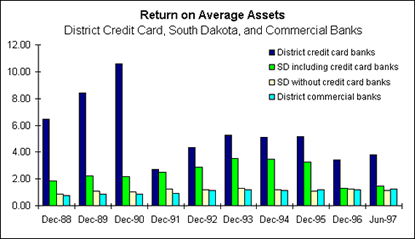What is the typical Ninth District bank? The importance of manufacturing, small business and farming to the district's economy has naturally led banks to specialize in those areas. As economies evolve, however, so do the banks that support them. Loans to consumers to pay for clothes, vacations and even groceries represent one of the fastest growing banking sectors in the district and nationwide.
This article briefly describes the rise of the credit card banks that make this consumer credit available, and how those banks are changing the landscape of district banking.
What is a credit card bank?
The district currently has nine "credit card" banks—defined as insured financial institutions with the primary business of making credit card loans. Credit card banks are chartered as commercial banks, but their activities are limited to credit card operations by the Competitive Banking Act of 1987.
During the late 1970s and 1980s, several states, including South Dakota, enacted legislation known as limited purpose banking laws. South Dakota also enacted legislation that exempted credit card banks from the state's usury limit. The purpose of such legislation was to encourage banks with activities like credit card operations to locate in the state, and thus spur employment and economic development. Eight of the district's nine credit card banks are located in South Dakota, with five in Sioux Falls. Citibank South Dakota, N.A., is by far the largest of the nine banks and held 87 percent of total credit card loans in the district on June 30, 1997.
District lending patterns
The nine credit card banks now account for the same portion of total loans in the district as all agricultural banks combined—14.8 percent in 1996. (Regulatory agencies consider a bank that makes more than 25 percent of its loans for agricultural purposes an agricultural bank.) Five years ago, however, agricultural banks made almost 17 percent of district loans vs. 11 percent by credit card banks.
District profitability
The district's credit card banks have consistently outperformed commercial banks. In second quarter 1997, the nine banks were three times more profitable than the district's commercial banks.
Banks in South Dakota were twice as profitable on average during the last five years, thanks to the states' credit card banks (see graph). The effect of the banks on districtwide profitability was much smaller: Credit card banks made the district on the whole just 3 percent more profitable during the same period.
The profitability of credit card banks is also much more volatile than that of commercial banks. Profitability during the last 10 years has ranged from a high of 10.59 percent return on assets in 1990 to a low of 2.7 percent the following year, while the profitability of commercial banks has ranged from 0.74 to 1.25 percent.
Declining consumer loan quality
By design, credit card banks have a very large exposure to consumer loan quality. This risk requires credit card banks to devote resources to technology and to gaining expertise in risk management functions.
The last few years have been tough on credit card issuers, as consumer credit delinquencies have risen and personal bankruptcies have reached record numbers. In second quarter 1997 banks nationwide reported the highest level of credit card losses in 14 years. Half the nation's 74 credit card banks had declining earnings during the quarter and 14 reported losses.
In the district, though, credit card banks' profitability increased 51 percent during second quarter 1997, and credit card losses declined 4 percent. The credit card banks also maintain higher levels of capital and loan loss reserves relative to district commercial banks, which should keep them in good shape even if they experience higher losses.







